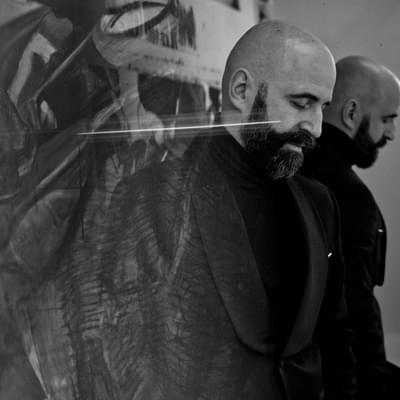Mendelssohn & Wagner

Full programme
- Mendelssohn, A Midsummer Night’s Dream: Overture (12mins)
- Wagner, Wesendonck Lieder (22mins)
- Roxanna Panufnik, Alma’s Songs Without Words (14mins)
- Mendelssohn, Symphony No.4 (Italian) (25mins)
Performers

Pierre Bleuse
Conductor
Jamie Barton
Mezzo Soprano
Introduction
I am thrilled that this afternoon’s concert with the City of Birmingham Symphony Orchestra will feature my piece Alma’s Songs Without Words.
I was commissioned to ‘re-imagine’ some Alma Mahler songs (originally for voice and piano) by the BBC Scottish Symphony Orchestra in 2020. The Songs are extraordinary pieces full of intensity, passion and almost feverish swings in mood and tempo. When Alma became engaged to Gustav Mahler, he wrote to her saying that there was only room for one composer in their marriage and these songs, to me, are full of raw emotion and passion, desperate to be expressed.
Alma was very proscriptive with musical expression – her instructions could move from verklärt/blissfully to Drängender/more urgently to Wieder ruhig/again calm in just the space of five bars! Reading about her personal life, one could compare these sudden dramatic changes of dynamic and moods (sometimes mid-phrase) to her frequent changes of romantic allegiance between the many men who were understandably captivated by her beauty and her brilliance. So, when orchestrating these songs, I have taken these changes of expression to an orchestral extreme – I would like to think that Alma would have approved of this approach.
Although this orchestration has no “Singstimme” (Voice), one section of the orchestra takes on the role of the singer in each song: in the first movement the cellos take on this role, then the oboes and cor anglais in the second movement and the French Horns for the third. Listen out for how these instruments adopt these roles and the colour they bring to each movement.
Each movement has an introduction by me – celestial strings and harp start the first, a thunderstorm of percussion and the patter of rain (by the winds rattling the keys of their instruments and the strings bouncing the wooden part of their bows on the strings) the starts the second. The third movement starts with a quiet transition from the happy A major ending of the second into a darker more contemplative F minor, for this nighttime Hymne.
I am so excited to hear the piece come to life with the CBSO under the baton of Pierre Bleuse. I feel a great bond with this orchestra – not only as we’ve had some very happy collaborations over the years but because my father, Andrzej Panufnik, was Chief Conductor of the orchestra from 1957 to 1959. Every time I’m working with the CBSO, it brings him back to life for me. The 2025-26 season will also feature a world premiere of my work, Aurora, commissioned by the CBSO, so I greatly look forward to sharing that with you!
For now, enjoy this exploration of the brilliant Lieder by Alma Mahler. Accompanied by a programme of Mendelssohn and Wagner too, you’re in for a treat!
Roxanna Panufnik
Composer
Programme notes
Wagner’s sumptuous Wesendonck Lieder were inspired by the poetry of Mathilde Wesendonck, the wife of his patron with whom he fell in love (somewhat unwisely). The exceptional Jamie Barton brings out every romantic word. Mendelssohn’s ‘Italian’ symphony is reminiscent of beautiful blue skies and brings a sunny conclusion to this lovely afternoon of music.
A Midsummer Night’s Dream: overture
Felix Mendelssohn (1809-1847)
Four woodwind chords float on the evening air; each tinted a different shade. Fairies dart, rustling and sparkling, through the moonlit woods. And then with a blazing flourish of sound, the full orchestra paints the regal splendour of Duke Theseus’s court. If you know your Shakespeare, you’ll already know the scene:
Four days will quickly steep themselves in night;
Four nights will quickly dream away the time…
By 1826, when the 17-year old Felix Mendelssohn wrote this overture, he definitely knew his Shakespeare. “From our youth we were entwined in A Midsummer Night's Dream and Felix particularly made it his own” recalled his sister Fanny. So listen out, too, for the sighs of Shakespeare’s young lovers and the braying of a bad actor with a donkey’s head: all rendered in orchestral sounds as enchanting – and unforgettable – as Shakespeare’s words.
Wesendonck Lieder
Richard Wagner (1813-1883)
“As I have never in my life known the true bliss of love, I will raise a monument to this most beautiful of all dreams, in which, from first to last, that love shall be completely fulfilled”, wrote Richard Wagner as he began work on his opera Tristan und Isolde – the world-changing love story that occupied him from 1857 to 1859. It’s never wise (and doubly foolish in Wagner’s case) to assume that art reflects its creator’s life; still, the mutual passion that he felt for Mathilde Wesendonck (1828-1902) was real enough. This was a forbidden love – they were both married; and in fact, Mathilde’s husband Otto had offered Wagner sanctuary and a home on his estate near Zurich after Wagner fled the revolution of 1849 in Dresden. She was intelligent, cultured and a gifted poet.
Whether or not their love ever became more than an unusually close and passionate friendship will never be known. But Wagner’s feelings certainly flowed into Tristan und Isolde; and then overflowed when, in response to the opera’s libretto, Mathilde sent him a series of poems. Between November 1857 and May 1858 he transformed five of the poems into songs, two of which (the third and fifth) he described as “studies” for Tristan und Isolde. Mathilde’s words and Richard’s music intertwine, merge and become one – achieving in art the union that the couple could never enjoy in life.
Naturally, then, these songs sing of longing: of an unattainable love, by turns painful and unimaginably sweet. Orchestrated by Wagner’s protégé Felix Mottl, they swiftly became popular, though to avoid public scandal, the author of the poems was kept anonymous until after Mathilde’s death in 1902 – since when they have been known, rightly, as the Wesendonck Lieder.
Alma’s Songs Without Words
Roxanna Panufnik (b. 1968)
The composer writes:
When the conductor Valentina Peleggi asked me if I would orchestrate some Alma Mahler songs for the BBC Scottish Symphony Orchestra, I was ashamed to say I had never heard them. They are extraordinary in their intensity, passion and almost feverish swings in mood and tempo. Reading about her personal life, one could compare these sudden changes in dynamics and mood to her frequent changes of romantic allegiance between the many men who were understandably captivated by her beauty and brilliance.
Alma’s Songs Without Words reimagines three Alma Mahler lieder for orchestra. In each of the three songs, a section of the orchestra takes on the role of the voice. In Hymne, the singing qualities of the cello perfectly capture the plaintiveness of the human voice. I emphasize the majestic hymn-like chords of the accompaniment and have added a short introduction where harp and violins play on the first four notes of Alma’s melody, using celestial harmonics.
The oboes and cor anglais take the vocal line in Ansturm, which reminds me of a summer storm – short but powerful in its emotional impact. I have injected ‘thunder’ and the sound of falling rain into the introduction. A transition is needed to take us from the happy relief at the end of the storm to the lonely and wistful beginning of Hymne an die Nacht. This transition recalls the hymn-like atmosphere of Hymne through the horns, which act as the singers for this song. They are muted, rather like Alma’s creative expression when she married Gustav Mahler: although he allowed her to reignite her creative flame eight and a half years into their marriage, she could never forgive him for stifling it in the first place. Alma’s beautiful and plaintive melody appears before the swift changes of tempo, dynamics and emotion return.
Symphony No.4 in A major, Op.90 (Italian)
Felix Mendelssohn (1809-1847)
Felix Mendelssohn first travelled to Italy in the autumn of 1830, at the age of 21, and he drank it all in. “This is a truly glorious life!” he wrote from his room in Rome (No.5., Piazza di Spagna) to his father, back home in a wintry Berlin:
When I come into the room early in the morning and see the sun shining so brightly on my breakfast (you see, I could have been a poet) I immediately feel utterly contented; for it is now late autumn and who back home can still expect warmth or a blue sky, or grapes and flowers? After breakfast I begin my work, and play and sing and compose until noon.
He calls it work – but for someone who expressed himself through music as naturally as Mendelssohn did, it was only a matter of time before Italy started to work its magic on his creativity. Shortly before he left Rome for Naples, in March 1831, he reported that:
I have begun to compose with fresh vigour, and the Italian symphony makes rapid progress; it will be the most amusing piece I have yet composed especially the last movement.
Mendelssohn was a perfectionist. It would be March 1833, back in Berlin, before he finished polishing the symphony for a performance in London (where it was premiered on 13th May that year), and he continued to revise it afterwards. It was never published in his lifetime. But by some miracle, the Italian symphony managed to catch, on the wing, that first, fresh sunburst of colour, delight and youthful excitement: as Mendelssohn put it, “the most wonderful combination of gaiety and seriousness”. “My family will have told you of the exhilarating impression made on me by the first sight of the plains of Italy”, he wrote to his friend Zelter, and we can hear it too. The whole first movement seems to dance in the sunlight.
The symphony’s inner movements are gentler in tone: perhaps Mendelssohn could have been a poet after all? He was certainly a gifted watercolourist, and in the Andante con moto he uses muted orchestral shades and chant-like melodies to evoke a solemn procession amid the shadows of one of Rome’s great baroque churches (Mendelssohn ticked them all off his sightseer’s list). Next comes a lilting minuet, Con molto moderato. The horns blush like the evening sun.
And then, with a sudden snap and a pounding rhythm, we’re into the finale. It’s a saltarello – a flying, whirling Italian dance from Naples (the next stop on Mendelssohn’s tour, though he seems to have drafted the music in Rome). The energy is irresistible. Mendelssohn – a great maker of friends – enjoyed mixing with the colony of young French artists resident at the Villa Medici, where he saw the seventeen-year Louise Vernet dancing the saltarello with a tambourine in her hands. “What a superb picture she would have made!” he noted, before painting exactly that picture in the finale of his symphony.
© Richard Bratby